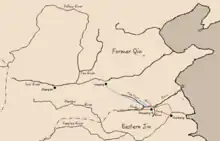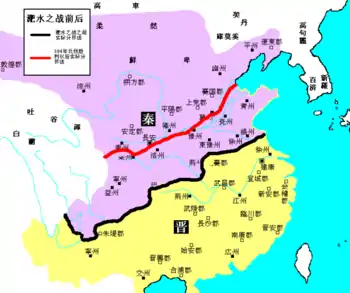| Battle of Fei River | |||||||||
|---|---|---|---|---|---|---|---|---|---|
 The situation during Battle of Fei River | |||||||||
| |||||||||
| Belligerents | |||||||||
| Former Qin dynasty | Eastern Jin dynasty | ||||||||
| Commanders and leaders | |||||||||
|
Fu Jiān (Emperor Xuanzhao of Former Qin) Fu Rong † Yao Chang Murong Wei Murong De Murong Bao |
Xie An Xie Xuan Xie Shi (謝石) Xie Yan (謝琰) Huan Chong Huan Yi | ||||||||
| Strength | |||||||||
| Book of Jin records 870,000[lower-alpha 1] | 80,000 elite Beifu troops | ||||||||
| Casualties and losses | |||||||||
| Book of Jin records 700,000+ | minimal | ||||||||
The Battle of Fei River, also known as the Battle of Feishui (simplified Chinese: 淝水之战; traditional Chinese: 淝水之戰; pinyin: Féishǔi zhī zhàn), was a battle in 383 in China, where forces of the Di-led Former Qin dynasty were decisively defeated by the outnumbered army of the Eastern Jin dynasty.[4] The location of the battle, the Fei River, no longer exists but is believed to have flowed through modern Lu'an, Anhui, near the Huai River.[5] The battle is considered to be one of the most significant battles in Chinese history.[6] In the aftermath of the battle, the Former Qin fell into a massive civil war, resulting in its eventual collapse, ensuring the survival of Eastern Jin and subsequent Han-ruled regimes south of the Yangtze River.[6]

Background
The state of Former Qin, led by ethnic Di (氐) tribesmen,[4] rose rapidly from a string of successes in the 350s. Fu Jiān, the nephew of the founder Fu Jiàn, was a vigorous leader of tremendous drive and ambition.[6] In 370 he conquered the state of Former Yan and in 373 seized modern Sichuan and Chongqing from Jin. In 379, the strategically important city of Xiangyang, gateway to the Middle Yangtze, fell to Qin. By 381, he had conquered all of north China and was preparing for an invasion of the south.[7][8]
In May 383, a Jin army of 100,000 commanded by Huan Chong attempted to recover Xiangyang but was driven off by a Qin relief column of 50,000 men.[9] In response, Fu Jiān ordered a general mobilization against Jin: 6 of every 10 able-bodied men were conscripted, and 30,000 elite guards (羽林郎) were gathered. In August 383, Fu Jiān sent his brother, Fu Rong, the Duke of Yangping (who had opposed the campaign), with an army of 300,000 as the advance force. Later that month, Fu Jiān marched with his army of 270,000 cavalry and 600,000 infantry from Chang'an.[9] In September, Fu Jiān reached Xiangcheng. Separate columns were to push downstream from Sichuan, but the main offensive would occur against the city of Shouchun on the Huai River. Emperor Xiaowu of Jin hurriedly made preparations for defense. He gave Huan Chong responsibility for the defense of the Middle Yangtze. The pressing defense of the Huai River was given to Xie Shi (謝石) and Xie Xuan (謝玄) and the elite 80,000-strong Beifu Army (北府兵).[9] Prime Minister Xie An oversaw overall strategy.[7][8]
Former Qin Army
Fu Jiān's force was composed of many smaller armies levied from the conquered northern territories, along with cavalry drawn from the nomadic peoples of the north (the Xianbei and Xiongnu).[4] Most men had little or no loyalty to the Former Qin, and many were forced to join or joined only because of military rations and pay. Many battalions had problems following orders as instructed by their commanding officers. Fu was warned of the poor training of his heterogeneous army, but instead chose to rely on the vast number of men that made up the army, saying, "My army is so huge that if all the men throw their whips into the Yangtze, its flow will be stopped," (投鞭断流) [4]
Jin Army
Xie Xuan's Beifu army was drawn from the militarized settlements of powerful local families, with officers bringing along their own hereditary troops. This army underwent significant training and could be considered a professional military unit.[10]
Battle
In October 383, the Former Qin forces under Fu Rong captured the important Jin city of Shouyang (壽陽, in modern Lu'an, Anhui).[9] Fu Jiān, seeing the possibility of achieving a quick victory, left his main force at Xiangcheng and led 8,000 light cavalry to rendezvous with Fu Rong. Fu Jiān sent captured Jin official Zhu Xu as a messenger to try to persuade Xie Shi to surrender.[9] Instead, Zhu tipped off Xie Shi to the fact that the entire Former Qin force had not yet arrived and that he should try to defeat the advanced Former Qin forces to cripple the Former Qin's campaign.[9] At Zhu's suggestion, Xie Xuan and Liu Laozhi (劉牢之) led 5,000 elite troops to engage the advanced Former Qin force, scoring a devastating victory, killing 15,000 men.[9] Afterwards, Jin troops were lined up in a wide formation to give the illusion that the Jin forces could match Former Qin's manpower. Because of the early minor defeats and the Jin formation, Fu Jiān overestimated the amount of Jin forces.
In November 383, the Former Qin troops set up camp west of the Fei River.[9] The Jin forces stopped east of the Fei and could not advance.[9] Xie Xuan sent a messenger to Fu Rong, suggesting that the Former Qin forces retreat slightly west to allow Jin troops to cross the Fei River so that the two armies could engage.[9] Most Former Qin generals opposed that plan,[9] since maneuvering such a large army in that manner was too complicated for the benefits that might be obtained, especially with so many poorly trained troops. Fu Jiān overruled them, however, planning to attack the Jin army as it was crossing the river[9] to seize a tactical advantage, as the Jin would be split in two. Fu Rong agreed and ordered a retreat.[9]
The Jin's tactics of ambush and bribery now paid off. Many soldiers in the Former Qin army began to wonder why a sudden retreat order was given. Already retreating and demoralized, the Former Qin army went into a panic when Zhu Xu raised a cry of "the Qin army has been defeated" and it was routed.[4] Xie Xuan and generals Xie Yan (謝琰) and Huan Yi crossed the river and launched a major assault.[9] The "Qin is Defeated" rumor spread like wildfire, and chaos followed. Fu Rong personally tried to halt the retreat and reorganize his troops,[9] but his horse suddenly fell and he was killed by advancing Jin troops.[9]
The Jin generals noticed the chaotic footprints and wheel marks and declared that the Former Qin army was not in an organized retreat but was indeed in total disarray. The Jin soldiers continued their pursuit, and the entire Former Qin force collapsed.[9] A large amount of food and supplies were abandoned as Former Qin soldiers tried to escape with their lives. In the ensuing retreat and pursuit, an estimated 70-80% of the Former Qin troops died from combat, starvation, and exposure to the elements.[9]
Aftermath

The Jin army defeated the overwhelming Former Qin forces with only minor casualties. The Jin had routed and killed most of the escaping soldiers of the Former Qin army, greatly weakening the pool of troops from which the Former Qin could draw. Fu Jiān's forces were not able to be reorganized, even after he eventually withdrew to Luoyang under the protection of Murong Chui, whose 30,000-man army was one of the few that did not collapse.[8]
Meanwhile, agrarian rebellions arose after news of the defeat at Fei River. Murong Chui used this opportunity to ask Fu Jiān to let him try to lead an army to pressure the rebels in the eastern empire back into submission. Instead, Murong Chui himself rebelled in early 384, which started a chain reaction of many Xianbei and Qiang uprisings. The Former Qin capital Chang'an would fall in 385 to the Xianbei forces of Western Yan, and Fu Jiān himself would die later that year at the hands of his former general Yao Chang, the founder of Later Qin. While Former Qin would last until 394, it would never regain its power and glory.[11] In addition, after the battle, Jin forces advanced to the Yellow River and recovered much of the Chinese heartland, forming a basis for Liu Yu's expeditions and the Southern and Northern dynasties period that would follow soon afterward.
This battle is famous not only because of its significance in history but also because it demonstrated the importance of troop training, morale, loyalty and organized battle command. The battle was also significant in that it ensured South China would remain independent until 589 AD, when North China was again under a Han Chinese regime, the Sui dynasty.
References
- ↑ A 2012 study of the historicity of the battle and the accuracy of descriptions carried in historical texts concluded with strong possibility that the scale of the engagement was "dramatically exaggerated", but that it did indeed occur.[1] This study was spurred by a 1968 paper which called into question the historicity of the entire episode apart from the smaller initial sortie led by Liu Laozhi, based on the historical circumstances under which the records of the event were created and transmitted.[2] The myth theory was never widely accepted, having been largely refuted in 1996 by scrutiny of the subsequent rewards of the successful generals named, and the fact that records of the battle were carried by texts composed and transmitted by the defeated side, although the compilers of the Book of Jin were deemed "careless".[3]
- ↑ Diefenbach, Thilo (2012). "Die Schlacht am Fei (383) und ihre Folgen. Ein Beitrag zur chinesischen Historiographie nebst einer Übersetzung aus Sima Guangs Zizhi tongjian". Zeitschrift der Deutschen Morgenländischen Gesellschaft. Harrassowitz Verlag. 162 (2): 411–438. JSTOR 10.13173/zeitdeutmorggese.162.2.0411. Retrieved 2022-06-14.
- ↑ Rogers, Michael C. (1968). "The Myth of the Battle of the Fei River (A.D. 383)". T'oung Pao. Lieden: Brill. 54 (1/3): 50–72. doi:10.1163/156853268X00024. JSTOR 4527704. Retrieved 2022-06-14.
- ↑ Bielenstein, Hans (1996). "The Six Dynasties, Volume 1". Bulletin of the Museum of Far Eastern Antiquities. Stockholm. 68: 6–324 at 87–88.
- 1 2 3 4 5 C J Peers (1995). Imperial Chinese Armies (1) 200 BC - AD 589. Osprey Publishing. ISBN 1-85532-514-4.
- ↑ Bo Yang. Bo Yang Edition of the Zizhi Tongjian. Vol. 26.
- 1 2 3 Bo Yang (2002). "17". Zhongguoren Shigang 中國人史綱 [Summaries of the History of the Chinese People]. Vol. 1. Taipei: Yuanliu chuban 遠流出版.
- 1 2 Zizhi Tongjian (in Chinese). Vol. 104.
- 1 2 3 Zizhi Tongjian (in Chinese). Vol. 105.
- 1 2 3 4 5 6 7 8 9 10 11 12 13 14 15 16 17 18 Zizhi Tongjian (in Chinese).
- ↑ Lewis, Mark Edward (2011) [2009]. China Between Empires: The Northern and Southern Dynasties. Cambridge MA: Belknap. pp. 67–68. ISBN 9780674060357.
- ↑ Book of Jin. Vol. 114. Archived from the original on 2006-02-19. Retrieved 2006-10-17.
Book of Jin. Vol. 9. Archived from the original on 2006-02-19. Book of Jin. Vol. 79. Archived from the original on 2007-10-11. Book of Jin. Vol. 113. Archived from the original on 2006-02-19.